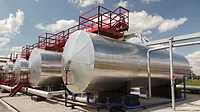The Future of Scientific Ocean Drilling
Close to
600 scientists from 21 countries met Sept. 23-25 in Bremen, Germany, to outline
major scientific targets for a new, ambitious ocean drilling research program.
The scientific community envisions that this program will succeed the current
Integrated Ocean Drilling Program (IODP), which ends in 2013. The outcome of
the Bremen meeting will result in a new science plan, enabling scientific ocean
drilling to further environmental understanding.
"This is a truly historic meeting," said the IODP vice-president Hans Christian Larsen. "Never before have so many scientists from the ocean drilling community met in one place. We were especially pleased to see so many young scientists – these researchers represent the next generation who will lead the new ocean drilling program, which is expected to start in 2013."
The 600 scientists attending the meeting discussed both established and new research fields. Potential predictability of geohazards, such as volcanic eruptions, earthquakes and tsunamis, also were addressed, in part linked to development of sub-seafloor laboratories more than 3 miles deep into the seabed.
Ocean drilling already has revealed discoveries such as confirmation of microbial life up to 5,249 feet below the seafloor, in rocks as old as 111 million years. Scientists now have started to explore this “deep biosphere,” but many critical questions remain unanswered.
During his plenary talk, Alan Mix of Oregon State University pointed out that the current level of CO2 injection into Earth's atmosphere soon will bring the CO2 concentration to a level not seen for many million of years, and on par with that of severe greenhouse conditions of the geological past. Only ocean drilling can provide records of the environment that ruled during these warm episodes during Earth's history, and investigate the true sensitivity of the climate to changes in CO2 concentration.
Ocean research drilling started more than four decades ago. Since then, about 200 expeditions have been completed and more than 217 miles of core have been recovered, documenting a much more dynamic Earth and climate than was previously thought to exist. In recent years, IODP, using multiple drilling platforms, has drilled in extremely challenging environments, such as shallow water carbonate reef systems very sensitive to sea-level change, and in the high Arctic, the last frontier area of ocean exploration on the Earth. Today, even deep drilling, up to 6 miles beneath the drillship, is possible.
"This is a truly historic meeting," said the IODP vice-president Hans Christian Larsen. "Never before have so many scientists from the ocean drilling community met in one place. We were especially pleased to see so many young scientists – these researchers represent the next generation who will lead the new ocean drilling program, which is expected to start in 2013."
The 600 scientists attending the meeting discussed both established and new research fields. Potential predictability of geohazards, such as volcanic eruptions, earthquakes and tsunamis, also were addressed, in part linked to development of sub-seafloor laboratories more than 3 miles deep into the seabed.
Ocean drilling already has revealed discoveries such as confirmation of microbial life up to 5,249 feet below the seafloor, in rocks as old as 111 million years. Scientists now have started to explore this “deep biosphere,” but many critical questions remain unanswered.
During his plenary talk, Alan Mix of Oregon State University pointed out that the current level of CO2 injection into Earth's atmosphere soon will bring the CO2 concentration to a level not seen for many million of years, and on par with that of severe greenhouse conditions of the geological past. Only ocean drilling can provide records of the environment that ruled during these warm episodes during Earth's history, and investigate the true sensitivity of the climate to changes in CO2 concentration.
Ocean research drilling started more than four decades ago. Since then, about 200 expeditions have been completed and more than 217 miles of core have been recovered, documenting a much more dynamic Earth and climate than was previously thought to exist. In recent years, IODP, using multiple drilling platforms, has drilled in extremely challenging environments, such as shallow water carbonate reef systems very sensitive to sea-level change, and in the high Arctic, the last frontier area of ocean exploration on the Earth. Today, even deep drilling, up to 6 miles beneath the drillship, is possible.
Looking for a reprint of this article?
From high-res PDFs to custom plaques, order your copy today!




